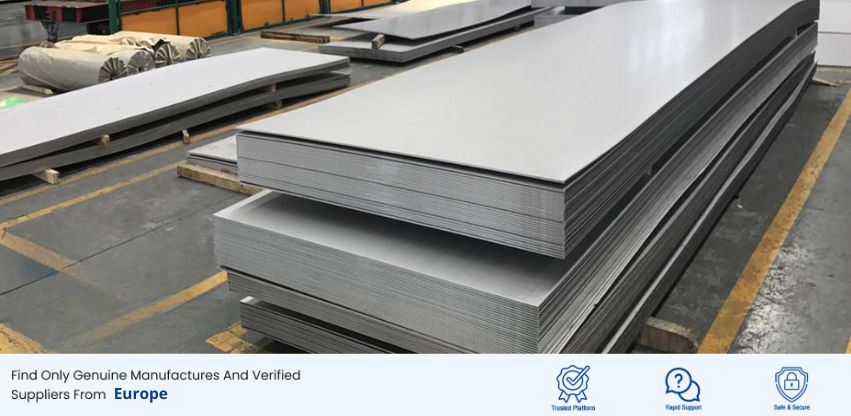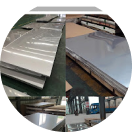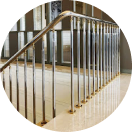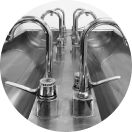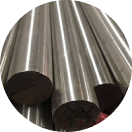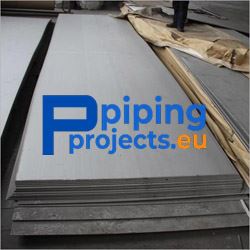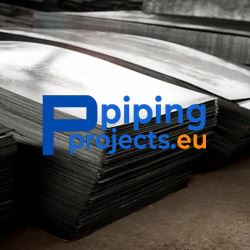Duplex Plate Manufacturers, Suppliers & Exporters in Europe - PipingProjects.eu
PipingProjects.eu is one of the leading Duplex Plate Manufacturer in Europe. Our advanced manufacturing facilities and stringent quality control protocols ensure unmatched reliability and longevity in every Duplex Plate we fabricate. Renowned for their superior corrosion resistance and aesthetic appeal, Duplex Plates from our European manufacturing centre epitomize our unwavering commitment to excellence. As a trusted Duplex Plate Supplier in Europe, we specialize in crafting premium plates that adhere to the highest industry standards. Our versatile plates cater to various industrial, commercial, and residential applications, underscoring our dedication to precision and customer satisfaction. With each shipment, we strive to exceed expectations, further solidifying our standing for excellence within the market.
What is Duplex Plate?
A Duplex Plate is a metal plate manufactured from a unique alloy composition typically comprising iron, nickel, chromium, and sometimes other elements like molybdenum and nitrogen. What sets Duplex Plates apart is their two-phase microstructure at room temperature, which seamlessly blends the characteristics of ferritic and austenitic stainless steels.
These plates find extensive use across various industries where high-performance materials are required, such as chemical processing, oil and gas exploration, marine engineering, and structural applications. They are sought after for their ability to withstand harsh environments, resist corrosion, and maintain structural integrity under extreme conditions.
Top leading Manufacturing Companies
What are the different grades of Duplex Plate?
- Duplex Stainless Steel 2205 (UNS S31803/S32205) is the most widely used duplex stainless steel grade. It offers good corrosion resistance, high strength, and excellent weldability.
- Duplex Stainless Steel 2304 (UNS S32304): This grade has a lower alloy content than 2205, offering good corrosion resistance in mild environments and higher strength than austenitic stainless steel.
- Duplex Stainless Steel 2507 (UNS S32750): Also known as super duplex stainless steel, this grade offers superior corrosion resistance, particularly in aggressive environments such as seawater and chemical processing applications. It has high strength and excellent resistance to pitting and crevice corrosion.
- Duplex Stainless Steel LDX 2101 (UNS S32101): This grade offers a combination of high strength, good corrosion resistance, and low nickel content for cost-effective solutions in various applications.
- Duplex Stainless Steel 2102 (UNS S32101): Similar to LDX 2101, this grade offers good strength and corrosion resistance properties with a lower nickel content.
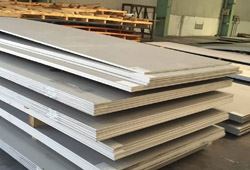
Duplex Plate
Duplex Plate - Specifications
- Product : Duplex Plate
- Thickness : 0.01 ~ 200mm
- Width : 1000mm, 1219mm, 1500mm, 1800mm, 2000mm, 2500mm, 3000mm, 3500mm
- Length : 2000mm, 2440mm, 3000mm, 5800mm, 6000mm, etc
- Standards : JIS, AISI, ASME, ASTM, AMS, GB, DIN, EN, GOST
- Finish : Surface finish of SS Plate: 2B, 2D, BA, NO.1, NO.4, NO.8, 8K, mirror, embossed, hair line, sand, blast, Brush, etching, etc
- Certification : SGS, BV, ISO, etc

Trusted
Supplier

Genuine
Product

Easy
purchase
Super Duplex Plate Specification Chart
Super Duplex Plate Specification & Grades
| Product |
Super Duplex Plate |
| Thickness |
1 to 100mm |
| Length |
upto 12 meters |
| Width |
1000 to 2500mm |
| Surface: |
Surface finish of Plate: 2B, 2D, BA, NO.1, NO.4, NO.8, 8K, mirror, embossed, hair line, sand, blast, Brush, etching, etc |
| Manufacturer: |
POSCO, Aperam, Jindal Stainless, DKC Korea, Thyssenkrup, Baosteel, TISCO, Arcelor Mittal, VDM,
Nippon Metal, Outokumpu |
| Package |
Shrink-wrapped ,Carton boxes,Wooden pallets,Wooden boxes ,Wooden crates Etc.
required. |
| Grade |
| Duplex
|
D S31803, D S32205, SD S32750, SD S32760, SD S32950. |
Applications of Duplex Plate in the Industry
- Oil & Gas Industry:
Duplex Steel Plates find extensive applications in the oil and gas sector, particularly in offshore drilling operations where exposure to harsh environments and corrosive conditions is prevalent.
- Chemical Industry:
Duplex Plates are commonly used in the chemical industry for handling corrosive chemicals and substances, thanks to their excellent corrosion resistance and durability.
- Pulp & Paper Industry:
Duplex Steel Plates are suitable for applications in the pulp and paper industry, where resistance to both chemicals and abrasion is essential for transporting corrosive liquids and slurries.
- Marine & Shipbuilding:
Duplex Steel Plates are employed in marine applications, including shipbuilding and offshore structures, where their corrosion resistance and high strength make them ideal for withstanding the challenging conditions of seawater.
- Power Generation:
Duplex Plates are used in power plants, especially in areas where exposure to aggressive chemicals or high-pressure conditions requires a corrosion-resistant material for transporting steam and other fluids.
- Construction:
In construction projects requiring corrosion-resistant and durable piping systems, Duplex Plates convey fluids in various structures, such as bridges and industrial facilities.
- Food & Beverage Industry:
Duplex Steel Plates are employed in the food and beverage sector, where hygiene and resistance to corrosion are crucial for transporting liquids and maintaining sanitary conditions in processing plants.
- Automotive Industry:
In specific automotive and transportation applications, Duplex Plates are used for their strength and resistance to corrosion, providing reliable performance in exhaust systems
Duplex Plate Size Chart
Explore our comprehensive Duplex Plate Size Chart ensuring optimal performance and longevity. As a leading Duplex Plate Supplier in Europe, we provide detailed gauge information for informed decision-making in various industrial applications.
Size Chart of Duplex Plate
| Size (in mm) |
Size (in inches) |
| 3.40 |
0.134 |
| 3.18 |
0.125 |
| 4.75 |
0.187 |
| 3.96 |
0.156 |
| 7.92 |
0.312 |
| 6.35 |
0.250 |
| 12.7 |
0.500 |
| 9.53 |
0.375 |
| 15.9 |
0.600 |
| 22.2 |
0.875 |
| 19.1 |
0.750 |
| 25.4 |
1 |
| 76.2 |
3 |
| 31.8 |
1.250 |
| 28.6 |
1.125 |
| 38.1 |
1.500 |
| 50.8 |
2 |
| 44.5 |
1.750 |
| 63.5 |
2.500 |
Advantages of using Duplex Plates
- Duplex Plates offer many advantages, making them highly desirable across diverse industrial and commercial sectors. Their remarkable corrosion resistance, particularly in aggressive environments like chemical processing plants and offshore installations, is a primary benefit.
- With a unique blend of ferritic and austenitic stainless steel characteristics, Duplex Plates boast superior strength, allowing for the construction of robust structures while maintaining cost efficiency through the use of thinner materials—moreover, their excellent weldability streamlines fabrication processes, enabling the creation of intricate components with ease.
- Notably, Duplex Plates resist stress corrosion cracking, a critical factor in environments rich in chlorides. This resilience translates into long-term durability and minimal maintenance requirements, ultimately leading to significant cost savings over the lifespan of equipment and structures. Their polished 2B finish enhances aesthetic appeal and extends their applicability to architectural and decorative purposes.
- Furthermore, due to their longevity, Duplex Plates contribute to environmental sustainability through recyclability and reduced material consumption. The myriad advantages of Duplex Plates, spanning from corrosion resistance to cost-effectiveness and environmental consciousness, underscore their indispensable role across a spectrum of industrial and commercial applications.
Various Types of Duplex Plate We Supply
PipingProjects.eu is a leading Duplex Plate Manufacturers in Europe. We supply different types of Duplex Plates to meet diverse industrial needs with superior quality and precision.
Weight Chart of Duplex Plate
As a trusted Duplex Plate Manufacturer in Europe, we provide comprehensive weights information to facilitate accurate decision-making in various applications.
Duplex Plate Weight Chart
| Thickness (inches) |
Density (lbs/in³8.72 g/cm³) |
DSS Plate Weight per Unit Area |
|
|
lbs/in² |
kg/m² |
| 3/16 |
0.315 |
0.06000 |
42.184176 |
| 1/4 |
0.315 |
0.08 |
56.245568 |
| 3/8 |
0.315 |
0.121 |
85.0714216 |
| 1/2 |
0.315 |
0.161 |
113.1942056 |
| 5/8 |
0.315 |
0.196 |
137.8016416 |
| 3/4 |
0.315 |
0.235 |
165.221356 |
| 7/8 |
0.315 |
0.274 |
192.6410704 |
| 1 |
0.315 |
0.313 |
220.0607848 |
| 1 1/4 |
0.315 |
0.391 |
274.9002136 |
| 1 1/2 |
0.315 |
0.47 |
330.442712 |
| 1 3/4 |
0.315 |
0.549 |
385.9852104 |
| 2 |
0.315 |
0.627 |
440.8246392 |
| 2 1/4 |
0.315 |
0.705 |
495.664068 |
| 2 1/2 |
0.315 |
0.784 |
551.2065664 |
| 2 3/4 |
0.315 |
0.862 |
606.0459952 |
| 3 |
0.315 |
0.941 |
661.5884936 |
How to prevent corrosion in Duplex Plates?
- Preventing corrosion in Duplex Plates involves implementing proactive measures and best practices tailored to the specific operating conditions and environmental factors. Firstly, thorough material selection is crucial, ensuring the duplex grade chosen aligns with the anticipated corrosive environment.
- Regular inspections and assessments of the operating conditions help identify potential corrosion risks early on. Employing corrosion-resistant coatings or inhibitors can provide additional protection against corrosive agents. Proper design considerations, such as avoiding crevices and ensuring adequate drainage, help mitigate areas prone to corrosion accumulation.
- Implementing effective cathodic protection systems can also safeguard Duplex Plates from corrosion by controlling the electrochemical reactions that lead to degradation. Routine maintenance, including cleaning and surface treatments, further extends the longevity of Duplex Plates by removing contaminants and restoring protective surface layers.
Duplex Plate Chemical Composition
As a trusted Duplex Plate Manufacturer in Europe, we specialize in producing top-quality Duplex Plates, offering corrosion resistance and superior chemical properties for diverse industrial applications.
Chemical Composition of Duplex Pipe
| |
N |
Mn |
C |
Si |
S |
P |
Mo |
Cr |
Ni |
| 2205 (S31803) |
min: 0.08 max: 0.20 |
2.0 max |
0.03 max |
1.0 max |
0.02 max |
0.03 max |
min: 2.5 max 35 |
min: 21.0 max 23.0 |
min: 4.5 max: 6.5 |
| 2205 (S32205) |
min: 0.14 max: 0.20 |
2.0 max |
0.03 max |
1.0 max |
0.02 max |
0.03 max |
min: 3.0 max: 35 |
min: 22.0 max 23.0 |
min: 4.5 max: 6.5 |
Duplex Plate Mechanical Properties
As a top Duplex Plate Supplier in Europe, we specialize in manufactruing Duplex Plates, offering superior mechanical properties for diverse industrial applications.
Mechanical Properties of Duplex Plate
| Material |
Elongation |
Yield Strength (min) |
Tensile Strength (min) |
Hardness(HB) max |
| Duplex |
25 |
65 |
90 |
217 |
Duplex Plate Thickness Tolerance Chart
Thickness Tolerance Chart of Duplex Plate
| Width (mm) |
w < 1200 |
1200< w <1500 |
1500< w <1800 |
1800< w <2100 |
2100< w <2400 |
2400< w <2700 |
2700< w <3000 |
| 2.5<t <4.5 |
0.20 |
0.20 |
0.20 |
0.20 |
|
|
|
| 4.5<t <6.0 |
0.23 |
0.25 |
0.28 |
0.30 |
0.80 |
0.80 |
0.80 |
| 6.0<t <8.0 |
0.30 |
0.30 |
0.32 |
0.36 |
0.80 |
0.80 |
0.90 |
| 8.0<t <10.0 |
0.32 |
0.35 |
0.38 |
0.40 |
0.80 |
0.80 |
1.0 |
| 10.0<t <12.5 |
0.35 |
0.38 |
0.40 |
0.45 |
0.80 |
0.80 |
1.0 |
| 12.5<t <16.0 |
0.80 |
0.80 |
0.80 |
0.80 |
0.80 |
0.90 |
1.0 |
| 16.0<t <20.0 |
0.80 |
0.80 |
0.80 |
0.80 |
0.90 |
1.0 |
1.1 |
| 20.0<t <25.0 |
0.80 |
0.90 |
0.90 |
0.90 |
1.0 |
1.1 |
1.3 |
| 25.0<t <30.0 |
1.0 |
1.0 |
1.1 |
1.1 |
1.1 |
1.3 |
1.4 |
| 30<t <40.0 |
1.4 |
1.4 |
1.5 |
1.5 |
1.5 |
1.7 |
1.8 |
Manufacturing Process of Duplex Plates
Duplex Plate is produced in seven steps. It manufactures a wide range of shapes, goods, and parts, ranging from Duplex Plate and Coil.
- Step 1 : Raw Material Selection
To begin the process of creating Duplex, raw materials such as iron ore and other elements including nickel, chromium, and molybdenum are carefully selected. The choice of alloying elements depends on the specific properties that the Duplex is intended to possess.
- Step 2 : Smelting and Melting
Once the raw materials have been selected, they are smelted in a furnace to create a molten metal alloy. The composition of the alloy is closely monitored and controlled to achieve the desired grade of Duplex.
- Step 3 : Forming
After the molten Duplex has been produced, it is cast into different shapes and forms, depending on its intended use. The most common shapes include slabs, billets, blooms, or ingots.
- Step 4 : Primary & Secondary Steelmaking
The subsequent step is primary steelmaking, which can be accomplished through different methods such as the Basic Oxygen Furnace (BOF) or the Electric Arc Furnace (EAF). At this stage, impurities like carbon are eliminated to achieve the desired chemical composition.
- Step 5 : Casting
The molten Duplex is then cast into semi-finished forms, which can take the shape of plates, sheets, bars, or other forms. Continuous casting or ingot casting methods are usually employed for this purpose.
- Step 6 : Hot Rolling
In the case of products like Duplex Plates, the semi-finished castings are hot-rolled to achieve the desired thickness and shape. During this process, the thickness of the castings is reduced while improving their mechanical properties.
- Step 7 : Cold Rolling and Annealing
In the case of specific Duplex products such as thin sheets and coils, cold rolling is employed to further reduce the thickness and enhance surface finish. To relieve stresses and enhance corrosion resistance, annealing is frequently performed.
